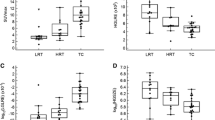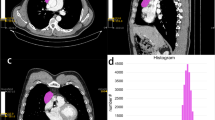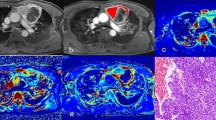Abstract
Objectives
To explore the value of combining apparent diffusion coefficients (ADC) and texture parameters from diffusion-weighted imaging (DWI) in predicting the pathological subtypes and stages of thymic epithelial tumors (TETs).
Methods
Fifty-seven patients with TETs confirmed by pathological analysis were retrospectively enrolled. ADC values and optimal texture feature parameters were compared for differences among low-risk thymoma (LRT), high-risk thymoma (HRT), and thymic carcinoma (TC) by one-way ANOVA, and between early and advanced stages of TETs were tested using the independent samples t test. Receiver operating characteristic (ROC) curve analysis was performed to determine the differentiating efficacy.
Results
The ADC values in LRT and HRT were significantly higher than the values in TC (p = 0.004 and 0.001, respectively), also in early stage, values were significantly higher than ones in advanced stage of TETs (p < 0.001). Among all texture parameters analyzed in order to differentiate LRT from HRT and TC, the V312 achieved higher diagnostic efficacy with an AUC of 0.875, and combination of ADC and V312 achieved the highest diagnostic efficacy with an AUC of 0.933, for differentiating the LRT from HRT and TC. Furthermore, combination of ADC and V1030 achieved a relatively high differentiating ability with an AUC of 0.772, for differentiating early from advanced stages of TETs.
Conclusions
Combination of ADC and DWI texture parameters improved the differentiating ability of TET grades, which could potentially be useful in clinical practice regarding the TET evaluation before treatment.
Key Points
• DWI texture analysis is useful in differentiating TET subtypes and stages.
• Combination of ADC and DWI texture parameters may improve the differentiating ability of TET grades.
• DWI texture analysis could potentially be useful in clinical practice regarding the TET evaluation before treatment.





Similar content being viewed by others
Abbreviations
- ADC:
-
Apparent diffusion coefficient
- CT:
-
Computed tomography
- DWI:
-
Diffusion-weighted imaging
- FOV:
-
Field of view
- HRT:
-
High-risk thymoma
- LRT:
-
Low-risk thymoma
- MRI:
-
Magnetic resonance imaging
- NEX:
-
Number of excitations
- ROC:
-
Receiver operating characteristic
- ROI:
-
Region of interest
- TC:
-
Thymic carcinoma
- TE:
-
Echo time
- TETs:
-
Thymic epithelial tumors
- TR:
-
Repetition time
- VOI:
-
Volume of interest
- WHO:
-
World Health Organization
References
Engels EA (2010) Epidemiology of thymoma and associated malignancies. J Thorac Oncol 5:S260–S265
Weis CA, Yao X, Deng Y et al (2015) The impact of thymoma histotype on prognosis in a worldwide database. J Thorac Oncol 10:367–372
Masaoka A, Monden Y, Nakahara K, Tanioka T (1981) Follow-up study of thymomas with special reference to their clinical stages. Cancer 48:2485–2492
Moon JW, Lee KS, Shin MH et al (2015) Thymic epithelial tumors: prognostic determinants among clinical, histopathologic, and computed tomography findings. Ann Thorac Surg 99:462–470
Ried M, Marx A, Gotz A, Hamer O, Schalke B, Hofmann HS (2016) State of the art: diagnostic tools and innovative therapies for treatment of advanced thymoma and thymic carcinoma. Eur J Cardiothorac Surg 49:1545–1552
Padda SK, Terrone D, Tian L et al (2018) Computed tomography features associated with the eighth edition TNM stage classification for thymic epithelial tumors. J Thorac Imaging 33:176–183
Huang J, Detterbeck FC, Wang Z, Loehrer PJ Sr (2010) Standard outcome measures for thymic malignancies. J Thorac Oncol 5:2017–2023
Falkson CB, Bezjak A, Darling G et al (2009) The management of thymoma: a systematic review and practice guideline. J Thorac Oncol 4:911–919
Li GF, Duan SJ, Yan LF et al (2017) Intravoxel incoherent motion diffusion-weighted MR imaging parameters predict pathological classification in thymic epithelial tumors. Oncotarget 8:44579–44592
Marom EM (2013) Advances in thymoma imaging. J Thorac Imaging 28:69–80
Hu YC, Wu L, Yan LF et al (2014) Predicting subtypes of thymic epithelial tumors using CT: new perspective based on a comprehensive analysis of 216 patients. Sci Rep 4:6984
Ozawa Y, Hara M, Shimohira M, Sakurai K, Nakagawa M, Shibamoto Y (2016) Associations between computed tomography features of thymomas and their pathological classification. Acta Radiol 57:1318–1325
Sadohara J, Fujimoto K, Muller NL et al (2006) Thymic epithelial tumors: comparison of CT and MR imaging findings of low-risk thymomas, high-risk thymomas, and thymic carcinomas. Eur J Radiol 60:70–79
Jing Y, Yan WQ, Li GF et al (2018) Usefulness of volume perfusion computed tomography in differentiating histologic subtypes of thymic epithelial tumors. J Comput Assist Tomogr 42:594–600
Henzler T, Schmid-Bindert G, Schoenberg SO, Fink C (2010) Diffusion and perfusion MRI of the lung and mediastinum. Eur J Radiol 76:329–336
Priola AM, Gned D, Veltri A, Priola SM (2016) Chemical shift and diffusion-weighted magnetic resonance imaging of the anterior mediastinum in oncology: current clinical applications in qualitative and quantitative assessment. Crit Rev Oncol Hematol 98:335–357
Coolen J, De Keyzer F, Nafteux P et al (2012) Malignant pleural disease: diagnosis by using diffusion-weighted and dynamic contrast-enhanced MR imaging--initial experience. Radiology 263:884–892
Razek AA (2012) Diffusion magnetic resonance imaging of chest tumors. Cancer Imaging 12:452–463
Abdel Razek AA, Khairy M, Nada N (2014) Diffusion-weighted MR imaging in thymic epithelial tumors: correlation with World Health Organization classification and clinical staging. Radiology 273:268–275
Priola AM, Priola SM, Giraudo MT et al (2015) Diffusion-weighted magnetic resonance imaging of thymoma: ability of the apparent diffusion coefficient in predicting the World Health Organization (WHO) classification and the Masaoka-Koga staging system and its prognostic significance on disease-free survival. Eur Radiol 26:2126–2138
Asselin MC, O'Connor JP, Boellaard R, Thacker NA, Jackson A (2012) Quantifying heterogeneity in human tumours using MRI and PET. Eur J Cancer 48:447–455
Choi MH, Lee YJ, Yoon SB, Choi JI, Jung SE, Rha SE (2018) MRI of pancreatic ductal adenocarcinoma: texture analysis of T2-weighted images for predicting long-term outcome. Abdom Radiol (NY). https://doi.org/10.1007/s00261-018-1681-2
Tian Q, Yan LF, Zhang X et al (2018) Radiomics strategy for glioma grading using texture features from multiparametric MRI. J Magn Reson Imaging 48:1518–1528
Skogen K, Schulz A, Helseth E, Ganeshan B, Dormagen JB, Server A (2018) Texture analysis on diffusion tensor imaging: discriminating glioblastoma from single brain metastasis. Acta Radiol. https://doi.org/10.1177/0284185118780889:284185118780889
Fritz B, Muller DA, Sutter R et al (2018) Magnetic resonance imaging-based grading of cartilaginous bone tumors: added value of quantitative texture analysis. Investig Radiol 53:663–672
Jiang X, Xie F, Liu L, Peng Y, Cai H, Li L (2018) Discrimination of malignant and benign breast masses using automatic segmentation and features extracted from dynamic contrast-enhanced and diffusion-weighted MRI. Oncol Lett 16:1521–1528
Nakajo M, Jinguji M, Shinaji T et al (2018) Texture analysis of (18)F-FDG PET/CT for grading thymic epithelial tumours: usefulness of combining SUV and texture parameters. Br J Radiol 91:20170546
Luciani A, Vignaud A, Cavet M et al (2008) Liver cirrhosis: intravoxel incoherent motion MR imaging--pilot study. Radiology 249:891–899
Li Z, Zhang D, Dai Y et al (2018) Computed tomography-based radiomics for prediction of neoadjuvant chemotherapy outcomes in locally advanced gastric cancer: a pilot study. Chin J Cancer Res 30:406–414
Travis WDBE, Müller-Hermelink HK, Harris CC (2004) World Health Organization classification of tumours. Pathology and genetics of tumours of the lung, thymus and heart. IARC Press, Lyon, pp 152–153
Jeong YJ, Lee KS, Kim J, Shim YM, Han J, Kwon OJ (2004) Does CT of thymic epithelial tumors enable us to differentiate histologic subtypes and predict prognosis? AJR Am J Roentgenol 183:283–289
Hoang UN, Mojdeh Mirmomen S, Meirelles O et al (2018) Assessment of multiphasic contrast-enhanced MR textures in differentiating small renal mass subtypes. Abdom Radiol (NY) 43:3400–3409
Lee HS, Jang HJ, Shah R et al (2017) Genomic analysis of thymic epithelial tumors identifies novel subtypes associated with distinct clinical features. Clin Cancer Res 23:4855–4864
Girard N, Ruffini E, Marx A, Faivre-Finn C, Peters S, Committee EG (2015) Thymic epithelial tumours: ESMO clinical practice guidelines for diagnosis, treatment and follow-up. Ann Oncol 26(Suppl 5):v40–v55
Lee HS, Oh JS, Park YS, Jang SJ, Choi IS, Ryu JS (2016) Differentiating the grades of thymic epithelial tumor malignancy using textural features of intratumoral heterogeneity via (18)F-FDG PET/CT. Ann Nucl Med 30:309–319
Ganeshan B, Goh V, Mandeville HC, Ng QS, Hoskin PJ, Miles KA (2013) Non-small cell lung cancer: histopathologic correlates for texture parameters at CT. Radiology 266:326–336
Feng Z, Rong P, Cao P et al (2018) Machine learning-based quantitative texture analysis of CT images of small renal masses: differentiation of angiomyolipoma without visible fat from renal cell carcinoma. Eur Radiol 28:1625–1633
Park JE, Kim HS (2018) Radiomics as a quantitative imaging biomarker: practical considerations and the current standpoint in neuro-oncologic studies. Nucl Med Mol Imaging 52:99–108
Padhani AR, Liu G, Koh DM et al (2009) Diffusion-weighted magnetic resonance imaging as a cancer biomarker: consensus and recommendations. Neoplasia 11:102–125
Priola AM, Priola SM, Gned D et al (2016) Diffusion-weighted quantitative MRI to diagnose benign conditions from malignancies of the anterior mediastinum: improvement of diagnostic accuracy by comparing perfusion-free to perfusion-sensitive measurements of the apparent diffusion coefficient. J Magn Reson Imaging 44:758–769
Acknowledgements
We would like to thank Dr. Xiao-Cheng Wei in GE Healthcare China for providing technical support regarding the application of Analysis-Kit software and supplementary Material (Texture Parameters Description.PDF).
Funding
This study has received funding from the Science and Technology Innovation Development Foundation of Tangdu Hospital (no. 2017LCYJ004).
Author information
Authors and Affiliations
Corresponding authors
Ethics declarations
Guarantor
The scientific guarantor of this publication is Guang-bin Cui.
Conflict of interest
The authors of this manuscript declare no relationships with any companies, whose products or services may be related to the subject matter of the article.
Statistics and biometry
Lei Shang kindly provided statistical advice for this manuscript.
Informed consent
Written informed consent was waived by the Institutional Review Board.
Ethical approval
Institutional Review Board approval was obtained.
Study subjects or cohorts overlap
Some study subjects or cohorts have been previously reported in Li GF, Duan SJ, Yan LF, et al Intravoxel incoherent motion diffusion-weighted MR imaging parameters predict pathological classification in thymic epithelial tumors. Oncotarget 2017;8(27):44579–44592.
Methodology
• retrospective
• diagnostic or prognostic study
• performed at one institution
Additional information
Publisher’s note
Springer Nature remains neutral with regard to jurisdictional claims in published maps and institutional affiliations.
Electronic supplementary material
ESM 1
(DOCX 124 kb)
Rights and permissions
About this article
Cite this article
Li, B., Xin, Yk., Xiao, G. et al. Predicting pathological subtypes and stages of thymic epithelial tumors using DWI: value of combining ADC and texture parameters. Eur Radiol 29, 5330–5340 (2019). https://doi.org/10.1007/s00330-019-06080-4
Received:
Revised:
Accepted:
Published:
Issue Date:
DOI: https://doi.org/10.1007/s00330-019-06080-4




